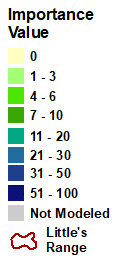gray birch (Betula populifolia)
Model Reliability: Low
| GCM SCENARIO | % Area Occ | Ave IV | Sum IV | Future/Current IV |
|---|---|---|---|---|
| Actual | 1.9 | 3.1 | 1698 | N/A |
| RFimp | 1.7 | 2.1 | 1078 | 0.63 |
| CCSM45 | 2.3 | 1.7 | 1138 | 1.06 |
| CCSM85 | 2.5 | 1.6 | 1199 | 1.11 |
| GFDL45 | 2.8 | 1.7 | 1359 | 1.26 |
| GFDL85 | 2.9 | 1.7 | 1443 | 1.34 |
| HAD45 | 2.5 | 1.6 | 1211 | 1.12 |
| HAD85 | 2.6 | 1.7 | 1299 | 1.2 |
| GCM45 | 3.1 | 1.4 | 1239 | 1.15 |
| GCM85 | 3 | 1.5 | 1314 | 1.22 |
Regional Summary Tree Tables
Summaries for tree species are available for a variety of geographies, in both PDF and Excel format. These summaries are based on Version 4 of the Climate Change Tree Atlas
Interpretation Guide
Gray birch is narrowly distributed (1.4% of area), sparse, low IV species largely confined to New England. Its model, of low reliability, shows a slight decrease in habitat (but still classed as 'No change'), and with a moderate adaptability and rare occurrence, we rate it with a poor capability to cope. SHIFT shows minor infill.
Family: Betulaceae
Guild: pioneer, dry or wet site tolerant, short lived
Functional Lifeform: small deciduous tree
| 3.6 | -1.14 |
| 0.03 |  |
MODFACs
What traits will impact gray birch's ability to adapt to climate change, and in what way?:
Primary Positive Traits
Dispersal Environment habitat specificity
Primary Negative Traits
Fire topkill Shade tolerance Insect pests Disease



